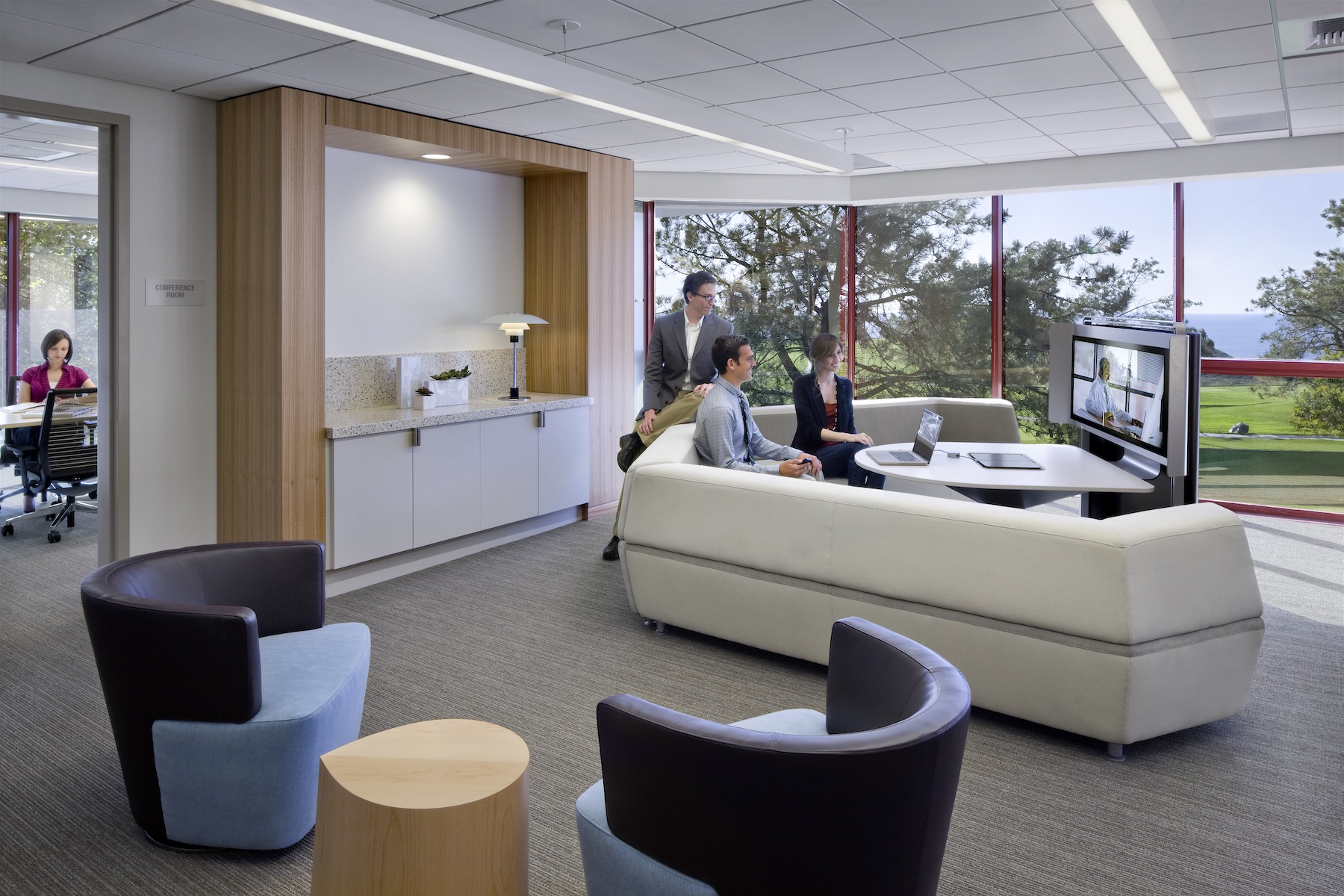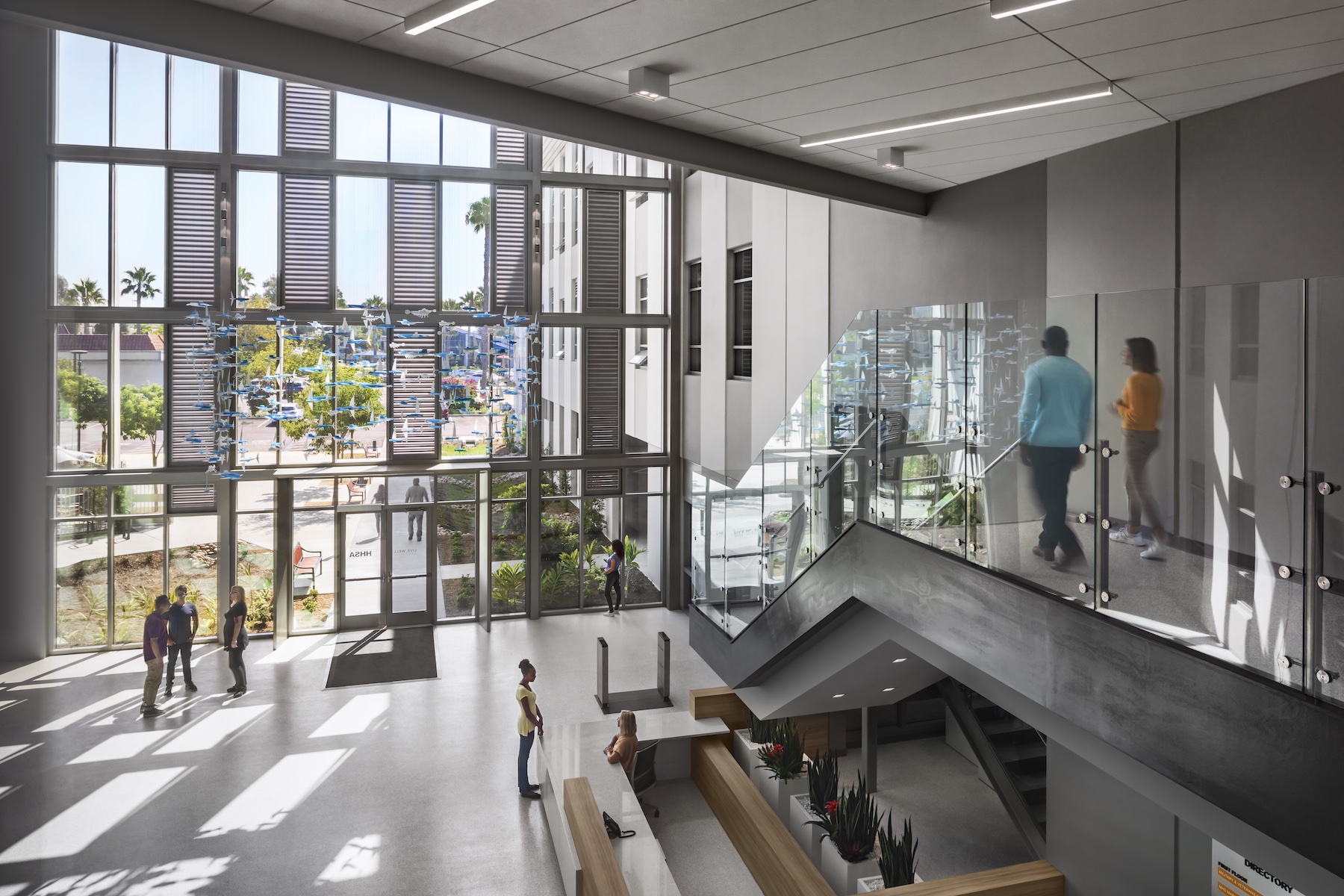The wake of the coronavirus pandemic has presented an opportune moment to re-evaluate and renew physical workplaces as employees return to them.
“The link between good workplace design and productivity is unmistakable,” states HMC Architects in its recently released report, titled “Designing for Wellness and Good Governance,” which focuses on design work done for public-sector clients by the firm’s six studios in California.
The report’s authors note that workplace design for the public sector comes with challenges. “As today’s office landscape becomes less hierarchical and younger staff more interested in a collaborative environment, employers must evolve to meet the needs of the next generation. Public optics, safety, many departments, and unique bidding processes must be considered.”

Those challenges are compounded by the shifting toward hybrid work and how offices must now function. “We are leaving behind a workplace that operates like a machine, where roles and responsibilities are clearly defined and predictable,” the authors write. “Our new future is a workplace that functions like an ecosystem and requires adaptability and unpredictable roles and responsibilities.”
The 28-page report, which can be downloaded from here, aims to present a “blueprint” to craft workplaces “that transcend functional utility and metamorphose into nurturing hubs of growth, connectedness, and mutual success.”
A holistic approach to wellness design

HMC Architects spells out what offices need to be doing today, starting with empowering people to do their best work. Cost-effective environments that blend flexibility, health, and wellness have a better chance at attracting new talent, enhancing employee satisfaction, and fortifying retention rates.
“Wellness is good business,” states the authors, pointing to studies that show that employee absenteeism is reduced, productivity increases, and employee turnover is significantly reduced. “Employee health and wellness investments make people feel valued and often encourage them to invest in their physical and mental well-being.”
However, creating a healthier work environment does not necessarily mean relocation or a complete revamp of existing space; there are cost-effective changes that can have significant impacts, such as bringing in new furniture and lighting for better comfort, temperature, mood, openness and flexibility. HMC says that prioritizing occupants’ thermal comfort is a “cornerstone” of a productive and content working environment
HMC’s solutions are holistic, encompassing the nurturing of wellness through healthier in-office nutritional choices and amenities such as fitness centers, private respite rooms, and access to outdoor recreational areas. “Investing in these purposeful amenities underscores a resolute commitment to cultivating a work environment that is supportive and engaging,” the report states. “Such an environment reflects a genuine concern for the welfare of employees.”
Case studies showcase different design approaches
The report homes in on seven public-sector “case studies” throughout California that amplify some of its general wellness points:
•The County of San Diego North Coastal Live Well Health Centers, whose interior design takes advantage of daylight and fresh air;
•The University of California San Diego North Torrey Pines Living and Learning Neighborhood, whose design balances privacy and collaboration in office spaces;
•Kaiser Permanente’s Fontana Medical Center, a Medical Office Building whose interior design includes biophilia inspired by nature;
•Riverside Office of Education Conference Center, whose design (elevates collaboration and comfort to encourage success;
•Los Angeles County Department of Public Works’ landscape Improvements that include a wellness garden which redefines the workplace experience;
•Mammoth Lakes Civic Center that reshapes the city hub; and
•The Ontario City Hall Annex that creates an office oasis. Along the building’s periphery, open office ergonomic workstations bask in daylight and offer glimpses of the outdoors, facilitated by intelligent sun control mechanisms that subdue glare. Internal offices, adorned with generous glazing, harness natural light cascading within.

The Riverside case study is an example of how design brings disparate elements together. The building’s ground floor serves as nexus for communal engagement, with an interplay between indoor and outdoor spaces. There’s a fusion of private space and open workspaces, and an expansive conference room within the building’s core. Overhead glass and sliding doors unveil a terrace that extends the conference space to an inviting outdoor area, commanding panoramic views of the neighboring landscape.
Related Stories
| Aug 20, 2013
Code amendment in Dallas would limit building exterior reflectivity
The Dallas City Council is expected to vote soon on a proposed code amendment that would limit a building’s exterior reflectivity of “visible light” to 15%.
| Aug 16, 2013
Today's workplace design: Is there room for the introvert?
Increasingly, roaming social networks are praised and hierarchical organizations disparaged, as workplaces mimic the freewheeling vibe of the Internet. Research by Susan Cain indicates that the "openness" pendulum may have swung too far.
| Aug 14, 2013
Green Building Report [2013 Giants 300 Report]
Building Design+Construction's rankings of the nation's largest green design and construction firms.
| Aug 13, 2013
DPR's Phoenix office, designed by SmithGroupJJR, affirmed as world's largest ILFI-certified net-zero facility
The new Phoenix Regional Office of DPR Construction, designed by SmithGroupJJR, has been officially certified as a Net Zero Energy Building by the International Living Future Institute (ILFI). It’s the largest building in the world to achieve Net Zero Energy Building Certification through the Institute to date.
| Aug 8, 2013
Stanley Hardware introduces Flexi-Felt for protecting floors
Stanley Hardware offers a solution to the frustrating problem of protecting your floors. The answer is Flexi-Felt®, an innovative product line that eliminates the aggravation of frequently replacing felt pads and leg tips that usually wear down or fall off, causing damage to expensive floors.
| Aug 8, 2013
New green property index could boost REIT investment in more sustainable properties
A project by the National Association of Real Estate Investment Trusts (NAREIT), the FTSE Group, and the U.S. Green Building Council to jointly develop a Green Property Index could help REITs attract some of the growing pool of socially responsible investment money slated for green investments.
| Aug 6, 2013
CoreNet: Office space per worker shrinks to 150 sf
The average amount of space per office worker globally has dropped to 150 square feet or less, from 225 square feet in 2010, according to a recent global survey conducted by CoreNet Global.
| Aug 6, 2013
Australia’s first net zero office building features distinctive pixelated façade
Australia's first carbon neutral office building, featuring a distinctive pixelated façade, recently opened in Melbourne.
| Jul 30, 2013
In support of workplace chatter
As the designers of collaborative work environments, architects and engineers understand how open, transparent spaces can cultivate the casual interaction and knowledge sharing that sparks innovation. Now a new study reveals another potential benefit of open workplaces: social interaction that supports happier employees.
| Jul 29, 2013
2013 Giants 300 Report
The editors of Building Design+Construction magazine present the findings of the annual Giants 300 Report, which ranks the leading firms in the AEC industry.














